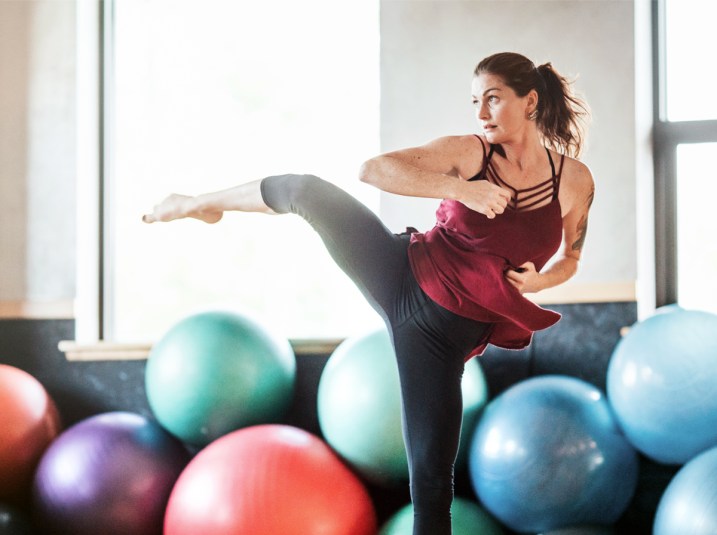How Kickboxing Can Help Reverse Type 2 Diabetes

A Type 2 diabetes diagnosis left Sandy Bandas, 40, feeling hopeless — until she found the fun workout that changed everything.
“Sandy, you need to listen to me,” implored her grandmother. In response, Sandy raised her head, wiping the tears from her cheeks. Her grandmother reached out and grasped her hands tightly. “I have diabetes, and look at me. I’m 95 years old and I’m still thriving. You can be too.”
“During that conversation with my grandmother, something clicked,” recalls Sandy. “Initially, after my Type 2 diabetes diagnosis, I was convinced that I was going to die young and that my life wasn’t worth living. But my grandma made me realize that I was wrong — and that I could still live the life I wanted to live.
Feeling lost and alone
“About eight years ago, my dad died from complications of diabetes. So before the doctor even told me I had the disease, I suspected the diagnosis was coming. Still, I was in denial for close to a year afterward, refusing to address my illness. I became depressed — I stopped spending time with my friends and pushed everyone away. For a while, I even stopped paying my bills. What was the point? I resigned myself to the fact that I would die soon.
“I started taking diabetes medication about three months after my diagnosis, but the pills had terrible gastrointestinal side effects. I’m a counselor, so I work with people, and my physical reaction was so bad that I was forced to leave in the middle of several sessions. The fact that I was unable to do my job made me sink further into my depression.
“I tried a keto diet in an attempt to get a handle on my diabetes, and while it helped me lose weight, I was miserable. Giving up carbs was a huge loss for me emotionally, so it was unsustainable. It also didn’t correct my blood-glucose levels.
“My doctor told me that exercise could help, so I tried the bike, the stair climber, and the treadmill, but they were so boring and monotonous. I just couldn’t force myself to keep up with a routine. I tried walking outside, but it was a slog — and I wasn’t losing weight or seeing changes in my blood-glucose levels. I felt like there was no way out.”
A total turnaround
“I had been getting Groupons for kickboxing classes for a while but was scared to go by myself. My sister encouraged me to try it, offering to attend the first class with me. I was nervous I wouldn’t be able to do it, worried it would be embarrassing and scared of people laughing at me.
“Having my sister at the bag next to me made me feel safe enough to give it a shot, but sure enough, the first time I tried to kick the bag, I fell and wound up on my butt. I cringed, but no one laughed, and I realized that there was nothing to be afraid of. Everyone was focusing on their own workout; no one was judging me or anyone else.
“After that first class, I was so physically exhausted, I could barely move. But at the same time, I felt revived, like I had finally found the thing that was going to drastically change my health. I thought to myself, This is what is going to keep me alive.
“I started going to kickboxing classes two or three times a week at CKO Richmond. There, I felt supported and cared for. At the beginning of every class, I set an intention, focusing on something I want to work through in the class, like my own feelings of not being strong enough, for example. After a warm-up, we do some shadowboxing, core work, and then 15 minutes of bag work at the end. When I punch the bag, I pretend I’m fighting all the things that led me to my diabetes diagnosis and fighting off my feelings of depression.
“Just two weeks in, I started to see muscles in my arms, and my face began to slim down. I was blown away by the results, and it gave me the motivation to keep going to class. As my cardiovascular fitness increased, I no longer struggled to breathe while walking up a flight of stairs or jogging with my dog. My diet improved without me even trying — when I work out, I want to reward my hard work with something healthy, instead of eating my feelings. And changing my diet drastically decreased the side effects I was experiencing from my medications.
“I’ve been going to classes for a little over a year, and my average blood glucose levels have dropped from 8.4 down to 5.3, which is considered normal by the American Diabetes Association. I definitely feel more hopeful and in control. And thanks to kickboxing, I’m confident I’m going to live a long, healthy, and happy life!”
How kickboxing combats insulin resistance and lowers blood glucose
A combination of aerobic and resistance training, like kickboxing, is most effective for combatting Type 2 diabetes.
“Aerobic exercise changes your muscle fibers, improving the action of insulin, while resistance training improves muscle mass, which increases glucose uptake,” explains Ronald Sigal, MD, a professor of medicine at the Julia McFarlane Diabetes Research Centre in Canada. The payoff: In one study, combining aerobic and resistance training dropped average blood glucose levels by as much as three times more than resistance or aerobic training alone.
To get the benefits, follow Sandy Bandas’ lead and try kickboxing two times a week. You can find a local gym that offers classes or try online tutorials.
Knee Strikes: Quickly lifting the knees increases heart rate to improve insulin sensitivity.
TO DO: Stand with your feet staggered, your left foot 12 inches behind your right. Bend your right knee slightly. Lift your left knee up, then tap your left foot on the ground. Continue tapping for 30 seconds. Switch sides; repeat with the right leg.
Plank: This move utilizes the rectus and transverse abdominis muscles to melt the belly fat that promotes high levels of blood glucose.
TO DO: Start on your hands and knees with your hands directly under your shoulders. Extend your feet straight back, forming a straight line from your head to your heels. Hold for 30 seconds
Squat Hook Combo: This two-part move builds glucose-burning muscle fibers in the butt and thighs.
TO DO: (A) Stand with your feet shoulder-width apart. Hold your clenched fists in front of your chest. Lower into a squat. (B) As you come up, step forward and punch across your body with your left fist. Return to center. Repeat, punching with the right. That’s one rep. Do six reps.
This story originally appeared in our print magazine.
More From FIRST
2 Simple Tips That’ll Finally Curb Your Sugar Cravings
This New Green Tea Supplement Is the Secret to Losing Weight and Keeping It Off
8 Yoga Poses You Can Do From Bed for Better Digestion and Gut Health










